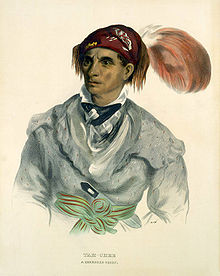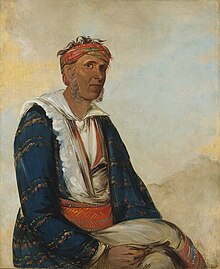Cherokee history
The first live predominantly in North Carolina, the traditional heartland of the people; the latter two tribes are based in what is now Oklahoma, and was Indian Territory when their ancestors were forcibly relocated there from the Southeast.
The Cherokee are members of the Iroquoian language-family of North American indigenous peoples, and are believed to have migrated in ancient times from the Great Lakes area, where most of such language families were located.
It was marked by dense town sites and extensive construction of platform mounds and other earthworks, used for religious and political purposes, and sometimes elite residences or burials.
[2] According to Benjamin A. Steere and the Western North Carolina Mounds and Towns Project, in association with the Eastern Band of Cherokee and University of Georgia, as the historic Cherokee developed in this area, they began to create a different kind of public architecture, one that emphasized large townhouses standing on top of the mounds.
[citation needed] In 1540, at the time of the Hernando de Soto expedition, the Southeastern Woodlands region was inhabited by peoples of several mound-building cultures.
Because warfare was considered a polluting activity, the priestly class conducted purification ceremonies of participants before they could reintegrate into normal village life.
[5][6] Early American ethnographer James Mooney, who lived with and studied the Cherokee in the late 1880s, was the first to write about the decline of the former hierarchy in relation to this revolt.
Linguistic analysis shows a relatively large difference between Cherokee and the northern Iroquoian languages, suggesting a split between the peoples in the distant past.
He was seeking an overland route to Mexican silver mines; the Spanish mistakenly thought the Appalachians were connected to a range in Mexico.
They also visited the Cherokee towns Nikwasi, Estatoe, Tugaloo, Conasauga, and Kituwa, but ultimately failed to gain dominion over the region and retreated to the coast.
In 1650 the Cherokee were estimated to have a population of 22,500 persons, living primarily in independent towns and smaller villages along the river valleys of the South Appalachian Mountains in parts of present-day eastern Tennessee, the western parts of what are now defined as the states of North Carolina and South Carolina, and northeastern Georgia.
The map accompanying the book, showed the Rickohockens occupying all of present-day southwestern Virginia, southeastern Kentucky, northwestern North Carolina and the northeastern tip of Tennessee.
Disguised as a Cherokee, Arthur accompanied the Chota chief on raids of Spanish settlements in Florida, Indian communities on the southeast coast, and Shawnee towns on the Ohio River.
By the late 17th century, colonial traders from both Virginia and Carolina were making regular journeys to Cherokee lands, but few wrote about their experiences.
[18] During the early historic era, Europeans classified the Cherokee towns by such terms as Lower, Middle, and Overhill to designate them geographically, in relation to the colonists' bases on the Atlantic coast.
[19] In the 1690s, the Cherokee founded a much stronger and more important trade relationship with the colony of South Carolina, which was based in the port of Charles Town on the Atlantic coast.
Moytoy's son, Amo-sgasite (Dreadful Water) attempted to succeed him as "Emperor" in 1741, but the Cherokee elected their own leader, Old Hop of Chota (sometimes spelled or recorded as Echota).
In the peace treaty ending the Seven Years' War, Britain took over the North American territories of defeated France east of the Mississippi River.
King George III issued the Royal Proclamation of 1763 forbidding British settlements west of the Appalachian crest, attempting to afford some protection from colonial encroachment to the Cherokee and other tribes, but the prohibition proved difficult to enforce.
Former warriors James Vann and his protégés Major Ridge (son of Pathkiller) and Charles R. Hicks, made up the "Cherokee Triumvirate" and became the dominant leaders, particularly of the younger, more acculturated generation.
[25] The Cherokee attempted to deal with the United States government as one sovereign and independent nation to another, but they suffered from internal divisions plus encroachment on their land and hostility by white settlers.
In 1816–1817, Andrew Jackson led an effort to force the Cherokee to migrate west of the Mississippi River and surrender their lands to the U.S. government.
The reform moved away from traditional decision making and decentralized power to establishing a Cherokee nation based on laws, institutions, and centralized authority.
[28][29] In the 21st century, carvings representing several symbols of the syllabary were discovered in a Kentucky cave, a sacred site of a burial of a Cherokee chief.
Facing removal, members of the Lower Cherokee, who lived in areas of the Piedmont of North Carolina and Georgia, were the first to move west.
Remaining Lower Town leaders, such as Young Dragging Canoe and Sequoyah, were strong advocates of voluntary relocation in order to preserve the Cherokee people, as they believed that the increasing number of European-American settlers, backed by the military of the US, were too much to resist.
Cherokees were displaced from their ancestral lands in northern Georgia and the Carolinas in a period of rapidly expanding white population.
President Andrew Jackson said removal policy was an effort to prevent the Cherokee from facing extinction, which he said was the fate of "the Mohegan, the Narragansett, and the Delaware".
Over 400 other Cherokee either hid from Federal troops in the remote Snowbird Mountains, under the leadership of Tsali (ᏣᎵ),[34] or negotiated directly with the state government to stay locally.
An additional 400 Cherokee stayed on reserves in Southeast Tennessee, North Georgia, and Northeast Alabama, as citizens of their respective states.










